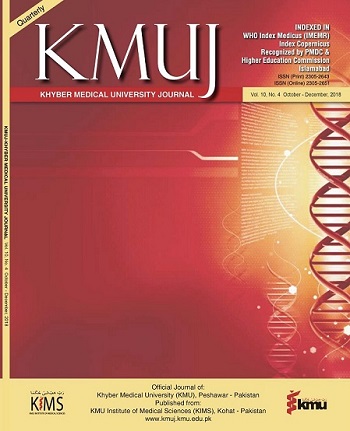QUANTITATIVE COMPARISON OF HANDGRIP STRENGTH BETWEEN CARDIAC PATIENTS AND AGE MATCHED HEALTHY CONTROLS USING A HANDHELD DYNAMOMETER
Main Article Content
Abstract
KEY WORDS: Grip strength (Non-MeSH); Dominant & Non-dominant (Non-MeSH); Cardiac patient (Non-MeSH); Myocardial Infarction (MeSH); Muscle Strength Dynamometer (MeSH); Muscle Strength (MeSH).
Article Details
Work published in KMUJ is licensed under a
Creative Commons Attribution 4.0 License
Authors are permitted and encouraged to post their work online (e.g., in institutional repositories or on their website) prior to and during the submission process, as it can lead to productive exchanges, as well as earlier and greater citation of published work.
(e.g., in institutional repositories or on their website) prior to and during the submission process, as it can lead to productive exchanges, as well as earlier and greater citation of published work.
References
REFERENCES
Hogrel J. Grip strength measured by high precision dynamometry in healthy subjects from 5 to 80 years. BMC Musculoskelet Disord 2015;16:139. DOI: 10.1186/s12891-015-0612-4.
Bocalini DS, Dos-Santos L, Serra AJ. Physical exercise improves the functional capacity and quality of life in patients with heart failure. Clinics (Sao Paulo) 2008;63(4):437-42. DOI: 10.1590/S1807-59322008000400005.
Izawa KP, Watanabe S, Osada N, Kasahara Y, Yokoyama H, Hiraki K, et al. Handgrip strength as a predictor of prognosis in Japanese patients with congestive heart failure. European Eur J Cardiovasc Prev Rehabil 2009;16(1):21-7. DOI: 10.1097/HJR.0b013e32831269a3.
Folland JP, Williams AG. The adaptations to strength training: morphological and neurological contributions to increased strength. Sports Med 2007;37(2):145-68. DOI: 10.2165/00007256-200737020-00004.
Cadogan A, Laslett M, Hing W, McNair P, Williams M. Reliability of a new hand-held dynamometer in measuring shoulder range of motion and strength. Man Ther 2011;16(1):97-101. DOI: 10.1016/j.math.2010.05.005.
Roberts HC, Denison HJ, Martin HJ, Patel HP, Syddall H, Cooper C, et al. A review of the measurement of grip strength in clinical and epidemiological studies: towards a standardised approach. Age Ageing 2011;40(4):423-9. DOI: 10.1093/ageing/afr051.
Van-Harlinger W, Blalock L, Merritt JL. Upper limb strength: study providing normative data for a clinical handheld dynamometer. PM R 2015;7(2):135-40. DOI: 10.1016/j.pmrj.2014.09.007.
Rozentryt P, Von-Haehling S, Lainscak M, Nowak JU, Kalantar-Zadeh K, Polonski L, et al. The effects of a high‐caloric protein‐rich oral nutritional supplement in patients with chronic heart failure and cachexia on quality of life, body composition, and inflammation markers: a randomized, double‐blind pilot study. J Cachexia Sarcopenia Muscle 2010;1(1):35-42. DOI: 10.1007/s13539-010-0008-0.
Hairi NN, Cumming RG, Naganathan V, Handelsman DJ, Le Couteur DG, Creasey H, et al. Loss of muscle strength, mass (sarcopenia), and quality (specific force) and its relationship with functional limitation and physical disability: the Concord Health and Ageing in Men Project. J Am Geriatr Soc 2010;58(11):2055-62. DOI: 10.1111/j.1532-5415.2010.03145.x.
Harris WS, Mozaffarian D, Rimm E, Kris-Etherton P, Rudel LL, Appel LJ, et al. Omega-6 fatty acids and risk for cardiovascular disease: a science advisory from the American Heart Association Nutrition Subcommittee of the Council on Nutrition, Physical Activity, and Metabolism; Council on Cardiovascular Nursing; and Council on Epidemiology and Prevention. Circulation. 2009;119(6):902-7. DOI: 10.1161/CIRCULATIONAHA.108.191627.
Chodzko-Zajko WJ, Proctor DN, Singh MAF, Minson CT, Nigg CR, Salem GJ, et al. Exercise and physical activity for older adults. Med Sci Sports Exerc 2009;41(7):1510-30. DOI: 10.1249/MSS.0b013e3181a0c95c.
Bohannon RW. Hand‐grip dynamometry predicts future outcomes in aging adults. J Geriatr Phys Ther 2008;31(1):3-10.
Forman DE, Clare R, Kitzman DW, Ellis SJ, Fleg JL, Chiara T, et al. Relationship of age and exercise performance in patients with heart failure: the HF-ACTION study. Am Heart J 2009;158(4 Suppl):S6-S15. DOI: 10.1016/j.ahj.2009.07.018.
Ashfield TA, Syddall HE, Martin HJ, Dennison EM, Cooper C, Sayer AA. Grip strength and cardiovascular drug use in older people: findings from the Hertfordshire Cohort Study. Age Ageing 2009;39(2):185-91. DOI: 10.1093/ageing/afp203.
Orr R, Raymond J, Singh MF. Efficacy of progressive resistance training on balance performance in older adults. Sports Med 2008;38(4):317-43. DOI: 10.2165/00007256-200838040-00004.
Conraads VM, Deaton C, Piotrowicz E, Santaularia N, Tierney S, Piepoli MF, et al. Adherence of heart failure patients to exercise: barriers and possible solutions. Eur J Heart Fail 2012;14(5):451-8. DOI: 10.1093/eurjhf/hfs048.
Piepoli MF, Conraads V, Corra U, Dickstein K, Francis DP, Jaarsma T, et al. Exercise training in heart failure: from theory to practice. A consensus document of the Heart Failure Association and the European Association for Cardiovascular Prevention and Rehabilitation. Eur J Heart Fail 2011;13(4):347-57. DOI: 10.1093/eurjhf/hfr017.
Schlüssel MM, Dos-Anjos LA, De-Vasconcellos MT, Kac G. Reference values of handgrip dynamometry of healthy adults: a population-based study. Clin Nutr 2008;27(4):601-7. DOI: 10.1016/j.clnu.2008.04.004.
Gayda M, Merzouk A, Choquet D, Ahmaidi S. Assessment of skeletal muscle fatigue in men with coronary artery disease using surface electromyography during isometric contraction of quadriceps muscles. Arch Phys Med Rehabil 2005;86(2):210-5. DOI: 10.1016/j.apmr.2004.07.351.
Baum K, Hildebrandt U, Edel K, Bertram R, Hahmann H, Bremer FJ, et al. Comparison of skeletal muscle strength between cardiac patients and age-matched healthy controls. Int J Med Sci 2009;6(4):184-91. DOI: 10.7150/ijms.6.184.
Berg HE, Eiken O, Miklavcic L, Mekjavic IB. Hip, thigh and calf muscle atrophy and bone loss after 5-week bedrest inactivity. Eur J Appl Physiol 2007;99(3):283-9. DOI: 10.1007/s00421-006-0346-y.
Tesch PA, Von-Walden F, Gustafsson T, Linnehan RM, Trappe TA. Skeletal muscle proteolysis in response to short-term unloading in humans. J Appl Physiol 2008;105(3):902-6. DOI: 10.1152/japplphysiol.90558.2008.
